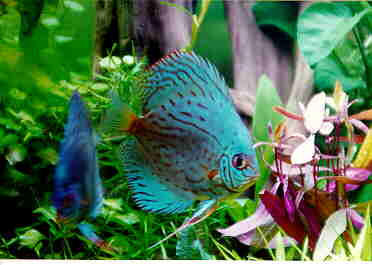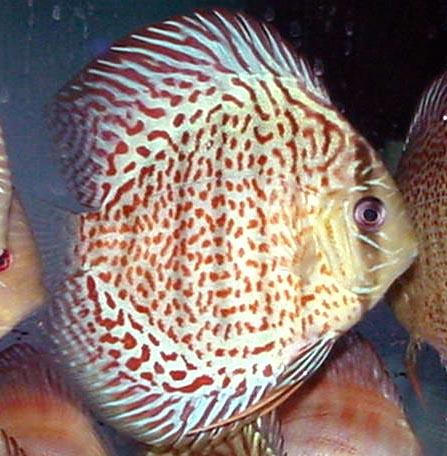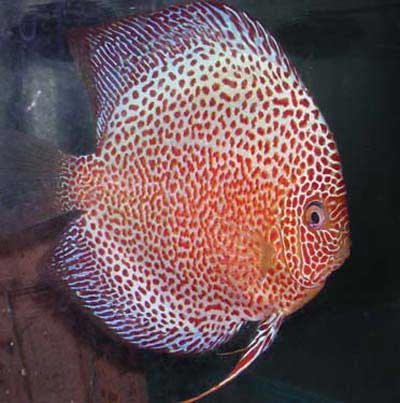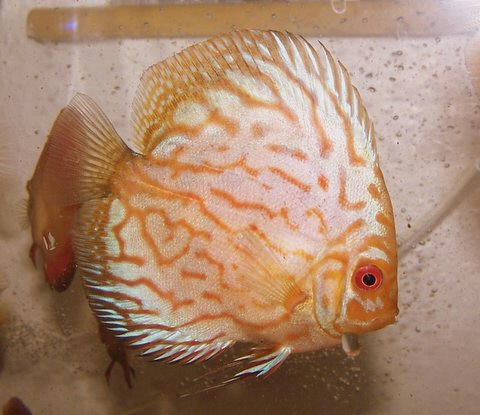| Data Sheet | | |
| Scientific Name: | Symphysodon | |
| Family: | Cichlidea | |
| Origin: | South America (Amazon) | |
| Adult Size: | 20-25 cm | |
| Social: | Good - see below | |
| Lifespan: | 10 years | |
| Tank Level: | mid dweller | |
| Minimum Tank Size: | 10-15 gallons (for small discus) | |
| Diet: | Omnivore - fussy eater | |
| Breeding: | Egglayer | |
| Care: | Medium-Hard | |
| Ideal pH: | 6.8-7.5 | |
| Temperature: | 26 – 30°C (79-86F) | |
| Tank setup:
| Smaller Discus seems to favoured plants in the aquarium, where they can hide and rest, but will eat the plants as well. | |
| Sexing: | Males tend to have pointed dorsal and anal fins. Females ones are more rounded. Males tends to have more patterns and less color, while female has more color and less pattern. Finally, males tend to be slightly bigger than the females. | |
| | Description:The discus is almost circular, or orb shaped with strong lateral compression. It has a small mouthed with a steep rising forehead. The dorsal and anal fins are rounded with a long base. The caudal fin is indented and the ventral fins are sabre-shaped. Although body patterns varies, most are showily coloured in shades of green, red, brown, and blue. The height and length of the grown fish are both about 20–25 cm (8–10 in). Habitat/Care:There are many articles on the care of discus. Discus are among the most difficult fish to keep in prime health. It appears that these fish are finicky, and they can die very easily. Some appropriate water conditions:
Mixing with other fishes:The discus are shy and peaceful aquarium inhabitants. They are sensitive to stress and disturbance or lack of protection. The best cohabitants may be angelfish (although many aquarists claim that keeping them together with angelfish will introduce parasites and/or diseases in them) and small fish like tetras. The Uaru is another preferred tank-mate of the discus. However, small fish may be intimidated by the big discus fish or even eaten. Small fish like neon tetras are often found in the gut of wild discus, so they might not be the ideal cohabitants, but the ideal food. Diet:Most discus are often extremely cautious about adapting to new foods; it's not unusual for them to go for weeks without food before accepting a new type of food. Whenever you buy discus, ALWAYS ASK WHAT THE FISH ARE EATING. After starving for a month discus will almost always accept a new food, but if you're buying younger fish, that can also stunt growth. Find out what sort of food the fish are accustomed to so you can get them eating in their new home right away. If you would prefer to feed them something else, you can then take your time to switch them over to the new food by mixing a little of it into their old food. One popular high-protein food often given to discus to promote good coloration and quick growth is beefheart. However, over feeding mammal protein over the long term can cause health complications, and a much better choice, which more people are moving toward today, is Krill, a shrimp-like crustacean. Allow them about 3 mins to eat, then remove all uneaten food and detritus daily as this will quick form ammonia and built up on nitrates in the water. |
Breeding:When well cared for and given a very varied diet these fish become sexually mature after about two to three years and will breed in the tank where they are being kept. They should never be transferred to a special breeding tank. A pair will separate themselves, usually during the spring, and chase the other fish as far as possible into a corner. Discus are typical open breeders with a quiet form of courtship and mating. The eggs are laid on rocks, more rarely on leaves, and they hatch in about 50 hours. Both parents tend the young, helping to "chew" them out of the egg membrane and transferring them to leaves. There they remain suspended by short filaments, are fanned by both the adults and finally start to swim after a further two to three days. In contrast to nearly all other fish the young feed not only on very tiny animals but also, and mainly, on a skin secretion produced by the parents This is produced by large one celled skin glands, mainly in the region of the back; these glands increase in number during the period of brood protection. The adults, and particularly the female, thus fulfill the function of a lactating cow. The fry do not in fact swim free very much, but attach themselves to the adults and suck at their skin. The parents alternate their duties at this time. The young will concentrate on one parent until a flip of its tail shakes them off and sends them to the other partner. Gradually, however, the young start to taken an increasing amount of small food from the open water, so they must be supplied with brine shrimp nauplii and rotifers. The young have a typical elongated fish shape, but soon become more rounded. They grow rather rapidly and by three months they are the typical Discus shape. The juvenile coloration changes to the definitive pattern after eight to nine months. Finally, it should be noted that Discus frequently eat their own eggs. Disease
| |
Photo Galley
Got a photo? Contact me.
 |  |  |
| | | |
 |  |  |
 | | |
Links to other awesome Discus sites:
1. http://www.greatlakesdiscus.com/ - Awesome range of discus fish for sale! Includes photo galley + customer's discus photo g
2. http://www.chensdiscus.co.uk/gallery/alley - Wow! beautiful range of discus fish for sale.
3. http://www.aquac-d.co.uk/gallery.htm - Another great site to purchase discus fish.
References Cited:
1. Discus (fish) [Online], Available http://en.wikipedia.org/wiki/Discus_(fish)
2. Caring for your discus fish [Online], Available http://ndnd.essortment.com/discusfishpet_rsss.htm
3. Symphysodon Aequifasciata [Online], Available http://badmanstropicalfish.com/profiles/profile14.html
4. How to keep discus [Online], Available http://www.discuspro.com/care3.htm
5. Sexing Discus Fish [Online], Available http://www.tinkerfish.com/discus/discus-archives/2005/08/sexing_discus_f.html#more
6. Discus worm [Online], Available http://www.clcdiscus.com/Discus-Deworming.html
7. Symphysodon aequifasciatus Blue discus [Online], Available http://www.fishbase.org/Summary/SpeciesSummary.php?id=11185
































No comments:
Post a Comment